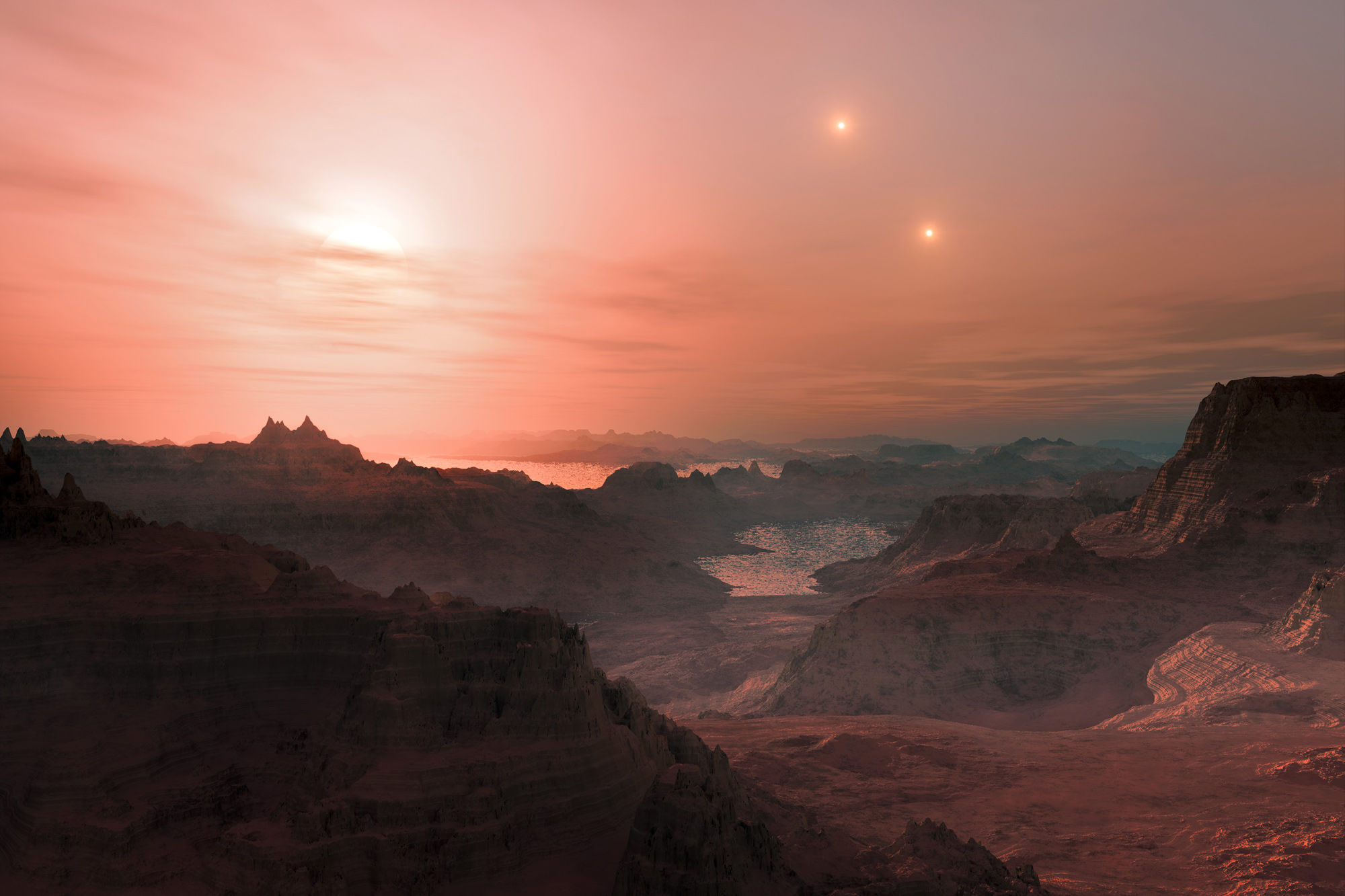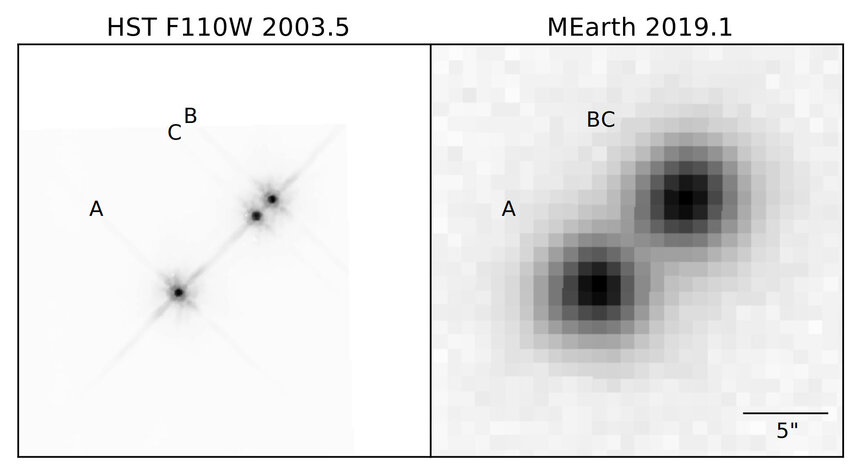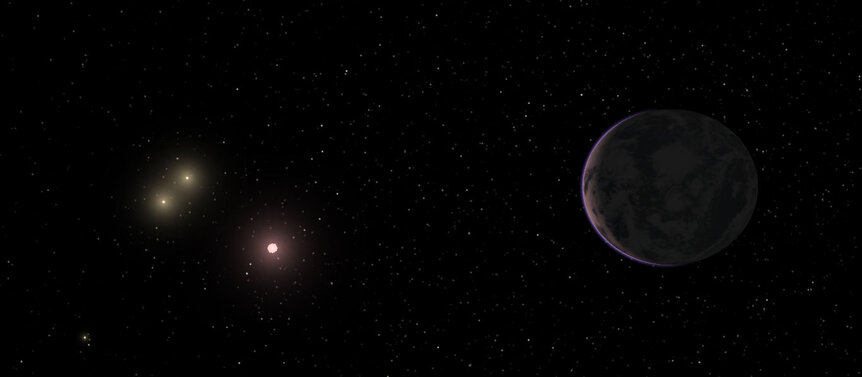Create a free profile to get unlimited access to exclusive videos, sweepstakes, and more!
TESS finds a super-Earth orbiting a star in a nearby triple-red-dwarf star system

As I mentioned recently, TESS — the Transiting Exoplanet Survey Satellite — is finding lots of interesting planets orbiting nearby stars. TESS is sweeping nearly the entire sky over its two-year nominal mission, looking at something like 200,000 stars for telltale dips in the brightness of each, indicating a planet (or planets) orbit there.
Because it’s looking at bright stars, this means it’s looking for the most part at nearby stars. An exoplanet it just found fits that bill: At just over 22 light years distant, it’s the second nearest transiting exoplanet seen*, and the closest to the Sun detected so far orbiting a tiny red dwarf!
But this story just gets better. The star is part of a triple system of red dwarfs.
Whoa.
The star system is called LTT 1445†. From the ground (and as seen by TESS, for that matter) it appears as one red star, but high-resolution images show it to be three. The brightest of the three stars is called LTT 1445A (note the capital letter), and the other two are B and C. Those last two orbit each other, and as a pair orbit A. This is called a hierarchical trinary (or just triple) star system.
The planet, LTT 1445Ab, orbits the primary star. We see that orbit nearly edge-on, so once per orbit it passes directly in front of the star as seen from Earth, causing a dip in the starlight. From that, and measurements of the size of the star, the planet was found to be 1.35 times the size of Earth, making it a super-Earth — bigger than Earth, but smaller than Neptune.
It orbits the star every 5.36 days, so its year is less than a week! The star is a red dwarf, meaning it’s smaller, cooler, and dimmer than the Sun. It’s only ¼ the Sun’s mass and radius, and less than 1% as bright. Even though it’s relatively close to us, you need a telescope to see it at all.
Even so, the planet is so close to the star — 6 million kilometers, far closer than Mercury is to the Sun — it gets baked. A decent estimate of its surface temperature is 160°C (or 320°F), hot enough to bake cookies on the ground were you so inclined. I wouldn’t be. Ouch.
So Earth-like it’s not. Just how unearth-like isn’t clear.
But we do know more about it. Observations using an instrument called HARPS were used to determine the mass of the planet, and it turns out to have at most 8.4 times Earth’s mass. A statistical analysis found a likely mass of 2.2 times Earth’s. That’s interesting, because that means it would have a density of about 90% Earth… which in turn means it’s made of slightly, but only slightly, less heavy stuff. Maybe it has a smaller iron core, or less rock and more water in the mantle and crust. These numbers are iffy, so this is just speculation. But it seems likely it’s a terrestrial planet, with at least a passing resemblance to Venus and Earth. Given the surface temperature, more like the former than the latter.
Too bad. What a view from there… The other two stars, the ones in the binary pair, orbit each other about a billion kilometers apart once every 36 years, and together the two take about 250 years to orbit the primary star. Their orbit is elliptical, and they go from about 30 billion kilometers from the primary to about six times more distant. If you were standing on LTT 1445Ab, at their closest they’d each be easily separated by eye, and about as bright as the full Moon as seen from Earth. But they’d be tiny, only about 1% the apparent size of the Moon; each just a point of light, eye-wateringly bright… and they’d fade by a factor of more than 30 over the course of a century or so as they moved to the far part of their orbit from the primary, only to start the cycle up again.
What mythologies, I wonder, would arise on such a world?
We have our own, of course, including a lot of science fiction, a lot of which in turn deals with planets orbiting in multiple star systems. And here we have one in a stellar triple that’s one of the closest systems in the entire Universe!
That’s one reason I love sci-fi. It’s only limited by our imagination, but the real Universe is what informs it… and the two here are dancing together quite closely.
*The closest planet orbiting a red dwarf is orbiting a red dwarf that is also the closest star to the Sun: Proxima Centauri. That planet was not found using the transit method, however.
†LTT stands for Luyten Two Tenths, a catalog of stars that are close enough to the Sun that their motion through space is measurable, and is more than 0.2 (i.e. two-tenths) of an arcsecond per year. An arcsecond is a tiny angle in the sky; the Moon is 1800 arcseconds across. Still, only close stars exhibit this much motion, and astronomer Willem Luyten cataloged 17,000 of them.





























